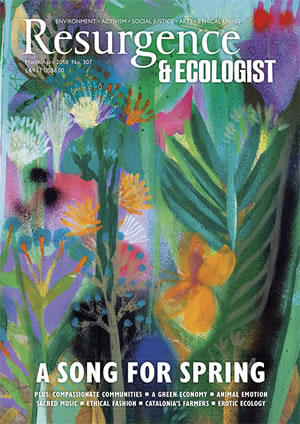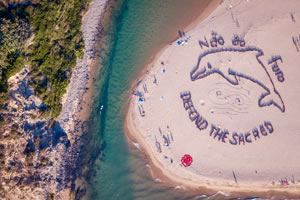“Mni Wiconi – water is life. Life is sacred. It is this sacredness that we defend. To secure our future, we have no other choice.” So begins the manifesto written by peace activists at the Defend the Sacred gathering in Tamera, Portugal in August 2017. The event drew together 40 leading activists, including initiators from Standing Rock and other Native Americans, as well as peace movement leaders from around the world. It also attracted community builders like me who came seeking inspiration.
The term ‘sacred activism’ was coined by spiritual teacher Andrew Harvey. He writes: “When the deepest and most grounded spiritual vision is married to a practical and pragmatic drive to transform all existing political, economic, and social institutions, a holy force – the power of wisdom and love in action – is born. This force I define as Sacred Activism.”
For some, the word ‘sacred’ has a purely religious meaning, and too many wars have been fought in the name of one faith or another. Others embrace a spiritual path to escape the grim realities of the world. For activists relying on scientific research to support a green future, the idea of connecting the political with the spiritual may not appeal.
However, in recent times those leaders who have been (and still are) a force for change in the world have drawn strength from their spiritual roots. Gandhi, The Dalai Lama, Nelson Mandela, Desmond Tutu, Satish Kumar and the originator of Engaged Buddhism, Thich Nhat Hanh, have relied on spiritual practice to develop resilience and self-awareness. They and the peace activists at Tamera agree that inner work is just as important as outer activity to ensure that we do not end up creating a dystopia in our enthusiasm to change the world. Satish Kumar realised on his 8,000-mile peace walk that he had to embody the peace he was seeking.
If we want to create a world that prefers compassion to competition, reveres the Earth and values life over profit, we may find nourishment in spiritual practices. We can find deeper community through ceremony and collaborate to heal the wounds of our past. Many believe that the cruelty apparent in our world is driven by deep trauma. Joseph Campbell’s concept of the hero’s journey teaches us that our shadow (individual or collective) needs to be embraced and integrated rather than opposed. Each person’s shadow aspects are those elements of their personality that are outside of their awareness. A society can have a collective shadow. During the moonrise ceremony at Tamera’s stone circle, an Israeli man embraced two Palestinians as they prayed for peace.
What do we hold sacred? Objects or places designated by specific religions with their particular laws and rituals that exclude non-believers? Or, alternatively, can we view the Earth and all her life forms as sacred in that they have intrinsic value rather than being there for our benefit? What if living beings were seen as ‘all our relations’, as the Native Americans refer to them? Indigenous wisdom can show us the way to reconnect to the Earth.
My experience and observations on the beach at Odiceixe in Portugal seemed to reveal the power of sacred activism. Around 250 of us from Tamera, augmented by local activists, had gathered there to take part in an action based around aerial art led by American artist and campaigner John Quigley. We were opposing the government’s plans to drill for oil off this beautiful stretch of coast. John sent us out to invite the sunbathers to join our action.
Before reaching our places, we walked past a ceremonial space where the cosmogram for water had been formed with stones. LaDonna Brave Bull Allard, initiator of the protest against the Dakota Access Pipeline at Standing Rock, and Sabine Lichtenfels, co-founder of Tamera, stood at either end of the spirals. Sabine blessed each passer-by with water, while LaDonna wafted smoke from a sacred fire towards each of us. Drums sounded, and as we sat in the sand, we noticed a seemingly never-ending stream of people from the beach coming to join us. John invited them to stand facing the sea. A long expanse of red fabric was unfurled, forming the proverbial line in the sand. The words ‘No to drilling, yes to the future’ were formed using our bodies, along with a huge dolphin representing the sea life we wanted to protect. More and more people appeared, and we cheered their arrival.
Something about the atmosphere we had created was drawing in people who would otherwise not have considered taking part in such an event. Our numbers had swelled to around a thousand. A hush fell, and the youth leader from Standing Rock, 13-year-old Tokata Iron Eyes, sang a haunting Native American song. The drone flew high above us to record the scene. John thanked everyone for being part of the event and announced: “You are all guardians of the oceans now.”
I was standing beside the red line, and together we held up the material and looked out to sea. Would the people who spontaneously took part in this action feel differently and act to defend the sacredness of the natural world? Would those who saw our message on social media, conveyed through the bodies of so many ‘guardians of the oceans’, be inspired to protect the Earth and her waters? Can such actions involving community and ceremony, celebrating the beauty of art as well as the beauty of Nature, bring about the shift “from mind to heart”, as the 17th Karmapa advocates? Perhaps the most effective actions and campaigns in service to our planet need to appeal to mind, heart and spirit.
Starhawk writes a Declaration of Four Sacred Things in her novel The Fifth Sacred Thing: “The Earth is a living, conscious being. In company with cultures of many different times and places, we name these things as sacred: air, fire, water, and earth. Whether we see them as the breath, energy, blood, and body of the Mother, or the blessed gifts of a Creator, or as symbols of the interconnected systems that sustain life, we know that nothing can live without them…
“To honor the sacred is to create conditions in which nourishment, sustenance, habitat, knowledge, freedom, and beauty can thrive. To honor the sacred is to make love possible.”
The Defend the Sacred Manifesto created by a group of activists in August 2017 is at defendthesacred.tamera.org, where you can watch the panels and talks and see photos and film of the event.







